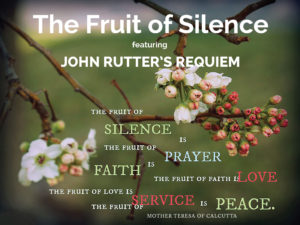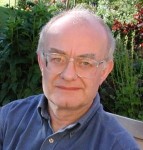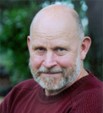
Saturday, March 25, 2023 at 8:00 pm
Pre-concert talk with director Freddie Coleman at 7:00 p.m.
1245 10th Ave East, Seattle, WA
The fruit of prayer is faith,
The fruit of faith is service,
The fruit of service is peace.”
– Mother Teresa of Calcutta
In March, winter gives way to spring and our mid-season concert features three works on a theme of darkness giving way to light.
Widely recognized by musicians worldwide, John Rutter is beloved for his lush melodies and orchestrations. Rutter’s Requiem is unmistakably optimistic in its message of hope and solace, expressed through uplifting musical themes and beautiful texts in both Latin and English.
Bob Chilcott’s Canticles of Light exudes comfort, and the texts, sung at the service of Compline in the evening and Matins in the morning, ask for God’s light to protect us through the night and to allay our fears.
In 2013 Latvian composer Pēteris Vasks set Mother Teresa’s universal prayer of peace to music, creating a hauntingly beautiful atmosphere that has become a staple for choirs around the
world.
I. Introit & Kyrie
II. Out of the Deep
III. Pie Jesu
IV. Sanctus
V. Agnus Dei
VI. The Lord Is My Shepherd
VII. Lux Aeterna

John Rutter

Jennifer Bromagen, soprano soloist
Though he is perhaps best known for his carols and other short pieces, John Rutter also has a number of large-scale works for chorus and orchestra to his name. Most of these received their first performances in the United States, where Rutter is a frequent visitor, writing regularly for American choirs and conducting performances of his own music.
The Requiem, completed in 1985, does not adhere strictly to the conventional Catholic liturgy, but combines texts from the Requiem Mass and the Book of Common Prayer. This is by no means unusual; Fauré, Brahms and Duruflé all followed their own individual preferences when selecting appropriate verses to set
The first movement comprises the Requiem aeternam and Kyrie Eleison. This is followed by a setting of Psalm 130, ‘Out of the deep have I called unto thee O Lord’ which begins darkly with an unaccompanied cello solo in C minor, later giving way to a more positive C major at the words ‘for with the Lord there is mercy, and with him is plenteous redemption’. As with the Requiems of both Fauré and Duruflé, the Pie Jesu focuses on the soprano soloist, though in this case with the addition of a subdued choral commentary. The Sanctus and Benedictus are both followed by an exhilarating Hosanna. In the Agnus Dei the Latin text alternates with verses from the Burial Sentences, taken from the 1662 Book of Common Prayer. At this point Rutter inserts his superb setting of the 23rd Psalm, notable for its plaintive oboe solo, delicate orchestration and sensitivity to the text. This exquisite and moving piece, though composed some seven years earlier for Mel Olson’s First United Methodist Church Choir in Omaha, was surely destined for this context, encapsulating as it does the work’s message of reassurance.
The last movement opens with another verse from the Burial Service, sung by the soprano soloist, which leads seamlessly into the Lux Aeterna, finally returning to the opening Requiem
aeternam theme for the peaceful conclusion.
The Requiem was first performed in its entirety on 13 October 1985 at the United Methodist Church in Dallas, Texas, conducted by the composer. Since then it has become a firm favorite with choirs and audiences the world over. Though it necessarily has its dark moments, Rutter’s Requiem is unmistakably optimistic in its message of hope and comfort, expressed through the beauty of the chosen texts and Rutter’s uplifting music. It is not entirely surprising that after the tragic events of 9/11 it was this setting of the Requiem that was the preferred choice of music at the many memorial services which followed across the USA.
1. Te lucis ante terminum
2. Christe qui splendor et dies
3. O nata lux de lumine
Bob Chilcott’s musical career began with the choir of King’s College, Cambridge, where he was a boy chorister and then a choral scholar. He later sang with and composed for The King’s Singers for twelve years. Since 1997 he has worked as a full-time composer, teacher and choral consultant, spending much of his time promoting choral music in this country and abroad, especially in the U.S.A. He is Conductor of the Royal College of Music Chorus and Principal Guest Conductor of the BBC Singers.

Bob Chilcott
Canticles of Light was commissioned in 2000 by Winchester Music Club in celebration of the 75th anniversary of its foundation by Sir George Dyson. The piece comprises three ancient Latin hymns that were in widespread use at least as early as the 10th century. The first two are evening hymns that ask for God’s protection and comfort through the night. The third hymn is a song for the morning, anticipating the renewed strength and hope that the day will bring.
The work is written for chorus and small orchestra, with a significant part for a choir of trebles or young voices, who in the two outer movements chant plainsong-like phrases above the main chorus. There are further parallels with the ancient and timeless art of plainsong in the scale-wise melodic contours and rhythmic independence of the main choral writing, whilst, at the other end of the musical timeline, Chilcott’s experience as a member of the King’s Singers is readily apparent in his skillful use of close-harmony techniques. His expert synthesis of these seemingly disparate elements has resulted in a musical language of considerable expressive power, eloquently conveying in these three short pieces a reassuring message of hope and renewal.
Mother Teresa was happy to surprise those she spoke to by handing them a small card with five concise sentences instead of a conventional business card. This short text, beginning with the line “The fruit of silence is prayer”, summarized her idea of God-believing, peace-making charity in a poetically condensed form.

Pēteris Vasks
In 2013, Latvian composer Pēteris Vasks created a musical setting of Mother Teresa’s “Prayer of Peace” which was commissioned by the Schleswig-Holstein Music Festival for mixed choir a cappella in the form of a densely woven elegiac sound stream. Slightly later, Vasks extended the work to produce a version with piano which in turn became the basis for a setting scored for mixed choir and string orchestra which was first performed in Riga in October 2014.
The composer characterizes this work as a very quiet meditation on the symbol of a path: “This path has five signposts — prayer, faith, love, service and peace. I want this composition to serve as a reminder that such a path exists.”
